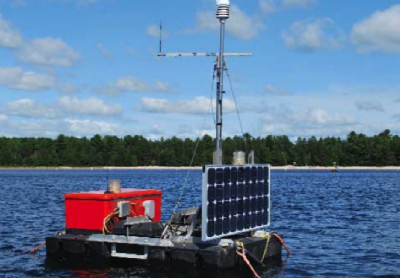Sensor-Based Networks
Redeployable Cyberinfrastructure for Environmental Observing Systems: Setting the Stage for Future Expeditions
MANY IMPORTANT PROBLEMS IN ENVIRONMENTAL SCIENCE, NATURAL RESOURCE MANAGEMENT, AND DISASTER RESPONSE REQUIRE SIMILAR TYPES OF CYBERINFRASTRUCTURE FOR DEPLOYING AND MANAGING SENSOR NETWORKS.

Extending Cyberinfrastructure to Sensor-Based Observational Networks.
Participants: Lake Deployment, U Wisconsin: Corinna Gries, Tim Kratz, Jordon Read, Tim Meinke, Ken Morrison; Forest Deployment, TFRI: Chau-Chin Lin, Yu-Huang Wang, Sheng-Shan Lu, UCSD, PRIME 2012: Sara Taghizadeh, Ariana Tsai;Coral Reef Deployment: Sally Holbrook, Russell Schmitt, Andy Brooks, Robert Carpenter; All Deployments: Peter Shin, Sameer Tilak, Gesuri Ramirez, Tony Fountain; Cycronix: Matt Miller
Researchers must be able to quickly and efficiently deploy sensor networks in remote and sometimes hostile environments to provide real-time data that will inform scientific analyses and policy decisions. These systems must support a variety of sensors, and need to provide sustainable power and communications services in areas where line power and wired networks are rare.
Although applications may have different science objectives (thus requiring different sensors and monitoring regimes), the underlying architectures and cyberinfrastructure is common. Our approach to address these application needs was to develop the DataTurbine Android Sensor Pod, a relatively inexpensive, easy-to-deploy, and robust end-to-end system (i.e., sensor to user) for environmental monitoring. Our approach is two-fold: first, to utilize the latest mature and stable technologies for mobile/embedded computing, communications/networking (including WiFi, satellite modems, and cell phones), streaming data middleware (Open Source DataTurbine), and cloud computing (the Amazon EC2 and the Open Science Data Cloud); and second, to integrate these technologies with custom software developed by our team into deployable hardware and software.
By design, the system minimizes the amount of ground/field support needed for a successful deployment by streaming the data in near-real-time directly from sensors to a cloud computing platform, which is scalable to adapt to changing loads (either from the source/sensor side or the demand/users side). The data can then be accessed and shared simultaneously by multiple users.
These features support scientific expeditions by enabling sensor networks to be deployed to remote and sometimes hostile environments quickly and with a minimum of on-site infrastructure. Our development approach involves working with scientists to design, prototype, deploy, test and improve the design for future deployments. Following are three examples where this system has been deployed and improved to support scientific research.
Lake Deployment at Crystal Lake in Wisconsin
Rainbow smelt, a cool-water fish species that was once introduced and became established in non-native lakes, led to the demise of native fish species such as yellow perch, cisco (or lake herring), or walleye, due to competition for food resources or direct predation. In the case of walleye, the introduction of rainbow smelt led to degradation of recreational fishing, an ecosystem service. A new approach to eliminating rainbow smelt - whole lake thermal manipulation takes advantage of the differences in thermal tolerances between smelt on the one hand, and yellow perch and walleye on the other. By experimentally mixing a lake via multiple large diaphragms stationed over the deepest spot in the lake during mid-summer, researchers expect that the deeper waters of a lake will warm sufficiently to eliminate the cool water habitat required only by the smelt. As of August 2012, we had observed that the diaphragms successfully warmed the bottom waters throughout the entire lake, stressing the rainbow smelt.
Forest Deployment at Lienhauchih Research Center, Taiwan
The impact of climate change on forest dynamics represents an important research topic for scientists at the Taiwan Forest Research Institute (TFRI). Understanding the processes that affect both plant and animal communities is critical for advancing scientific understanding and crafting rational management policies for these natural resources. Ecological science research at the Lienhuachih (LHC) Research Center of TFRI relies on numerous heterogeneous, integrated suites of sensors for observing physical and biological processes. During the summer of 2012, two UCSD PRIME students (Ariana Tsai, Sara Taghizadeh) worked in Taiwan with TFRI researchers to customize and deploy the sensor system for terrestrial ecology applications. That system included a weather station (air temperature, barometric pressure, relative humidity, rainfall, rainfall duration, rain intensity, wind speed, wind direction), video camera, and microphone. The project involved working with the Android operating system for the cell phone that was used in the communication system. In addition, the students created a tutorial for assembling a hardware component of the deployed system.
Coral Reef Deployment in Moorea, French Polynesia
While coral reefs have undergone unprecedented changes in community structure in the past 50 years, they now may be exposed to their gravest threat since the Triassic era. This threat is increasing atmospheric CO2, which equilibrates with seawater and causes ocean acidification (OA). Key to understanding this process is measurements by OA-related sensors including pH, PCO2, temperature, and pressure. The deployment of OA-related sensors at Moorea and Palmyra Atoll and the collection of measurements from these sensors can provide valuable insights into OA and lay the foundation for larger, more rigorous OA studies in the future. The ability to measure these phenomena in-situ and in real-time represents a significant advance in our ability to monitor key environmental processes, and as of January 2012, members from UCSD and University of California Santa Barbara (UCSB)/Moorea Coral Reef (MCR) travelled to Moorea to test the DataTurbine Android Sensor Pod system on the coral reef off of Gump Station. The lessons learned from this deployment led to changes in the system design that improved system robustness and reliability.
